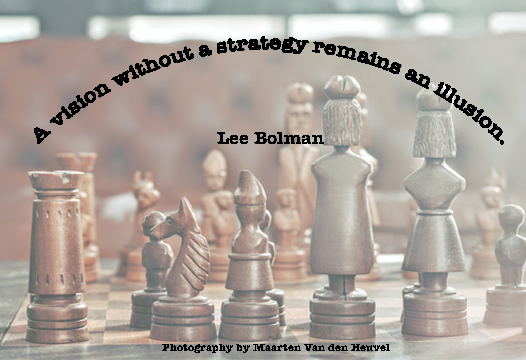|
Leadership is vision.
If I have no vision, then were am I going? Where am I leading those that have chosen to struggle with me to accomplish great things? Without vision we are a team with no goal. Even once we have a goal, we must have a strategy to achieve that goal, and a strategy without a great culture is a sure-fire way to fail at achieving that goal. I know that I harp on culture quite a bit. But we all know organizations that had a great vision, an amazing strategy, but a lousy culture. Where are those organizations today? Most have failed in achieving the goal they had, and many have been abject failures as a business. Their potential success devoured by a failed culture. To borrow a line from Jim Collins "Culture eats strategy for lunch." No matter how great my vision and strategy as a leader, if I don't spend the time creating a culture that nurtures success, that keeps my people and my customers engaged and feeling part of something much bigger than themselves, we will ultimately fail. Oh, we may achieve the goal, we might even excel at it, but if we leave behind a washed-up, burned-out staff, and a 4-page list of disgruntled ex-employees what do we have? Over the years I've worked, both in and out of leadership, I have seen examples of both good cultures and bad cultures. I've worked in places that transitioned from good to bad, and I'm sad to say that I have even created some of the bad cultures as a young, inexperienced "leader" ("practicing management without a license" as my friend John Graci says). In that time I have noticed three things that were consistent in those places that had great cultures and were inconsistent or completely lacking in those companies with poor cultures. Companies with great cultures: 1. Focus on team member strengths rather than weaknesses. A focus on strengths allows us to align our team so that each team member can bring their best performance to the table. When every team member is able to use their strengths each day to help accomplish the goals, they are more fulfilled and less stressed. NO, I am NOT saying ignore weaknesses and poor performance. But when we do have to have that conversation that no leader, or team member, wants to have (performance) both you and your employee will be in a much better position to actually correct their performance. By helping the team member identify their strengths, recognize how they can use them to better their performance they will do a much better job of converting their performance. 2. Have a culture that promotes team members to self-govern. Doing number one well will provide your team members with a process to self-identify issues (performance or inefficiencies/problems) and help feel more comfortable proactively in dealing with them. By empowering employees to make decisions about the process and how they achieve the goal (or improve the performance), we give them ownership of that performance and of the final product. Employees that feel ownership over the process and the results are much more likely to proactively deal with issues directly rather than feeling a need to come to you looking for a solution or validation. This allows you to spend your time leading rather than problem-solving for the team. 3. Practice direct communication rather than email or memo. Your team does not need another email or memo to spur them on to great performance. They need you to get out from behind your desk or door and talk to them. You can not lead from behind...to lead you need to be out front pointing the way and cheering them on. Leaders of great teams follow the advice of Tom Peters and implement MBWA (Managing By Wandering Around). Instead of being behind the desk crafting your next "inspiring" email, leaders who practice MBWA are out providing their team with face-time. Asking them about pain-points, bottlenecks, and inefficiencies, asking about what the team member would do to fix it, and then empowering them to fix it. They encourage employees to try new techniques, and to look for ways to be better. That kind of conversation will NEVER happen by email or by shotgun memo, it requires people being face-to-face discussing the issues, being open to feedback, and empowered to think differently. If you look at truly great organizations, that stay great for a long time, you will see these three leadership strategies being used to create a culture that encourages and empowers its people to be the best they can be. I can teach you how to put these in place with your team. Give me a call and we can talk in more detail about how you can benefit from creating a culture of empowerment and communication. Leave a comment below and share your list of practices you see that create a great culture that allows a team to excel!
0 Comments
|
AuthorScott is the owner and principle for Unilimited Pie. He has been many things in his life: Firefighter, Paramedic, Teacher, Business Owner, and Award Winning Leadership Development Expert. But what he is the most proud of are the leaders he has grown over the years in each of his roles. Leadership can be learned, if you have the right person to advocate for YOU. Archives
February 2020
Categories |

